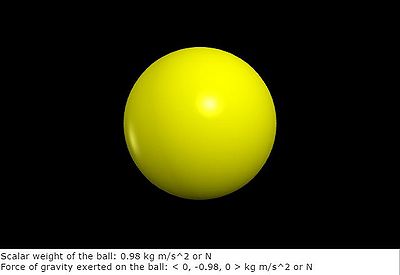Weight
Claimed by mxu86 (Michael Xu)
A page about weight as a property of matter.
The Main Idea
In physics, weight describes the Gravitational Force upon a mass, usually relative to Earth or a planet. Depending on the source, weight may be defined as a scalar - the magnitude of the gravitational force on an object - or a vector equal to gravitational force. An object's weight is commonly confused with mass, but instead it is a force that depends on another body of matter, while mass is an intrinsic property of matter.
A Mathematical Model
A mass m's weight near the surface of the Earth is represented by [math]\displaystyle{ {\vec{W} = \vec{F}_{g} = {m}\vec{g}} }[/math] where g is the gravitation acceleration of Earth, [math]\displaystyle{ {{\lt 0,-9.8,0\gt } \frac{m}{{s}^{2}}} }[/math].
Scalar weight would simply be the magnitude of the gravitational force, [math]\displaystyle{ {\left\vert{\vec{W}}\right\vert = \left\vert{\vec{F}_{g}}\right\vert} }[/math], and it can be simplified to [math]\displaystyle{ {\left\vert{\vec{W}}\right\vert = mg} }[/math].
A Computational Model
A simple segment of code that calculates the both scalar and vector weight (gravitational force) exerted upon a ball.

# Initializing sphere object
ball=sphere(pos=vec(0,0,0), radius=0.02, color=color.yellow, make_trail=true)
# Defining constants
g = vec(0,-9.8,0) #gravitational acceleration
ball.m=0.1 #mass of the ball in kg
W = ball.m*g #weight of the ball on Earth
# Printing values
print("Scalar weight of the ball:", mag(W), "kg m/s^2 or N")
print("Force of gravity exerted on the ball:", W, "kg m/s^2 or N")
Examples
Be sure to show all steps in your solution and include diagrams whenever possible
Simple
Determine the weight in Newtons of a 55 kilogram barbell on the surface of Mars, given the gravitational acceleration [math]\displaystyle{ {g}_{Mars} = 3.75\frac{m}{{s}^{2}} }[/math].
- [math]\displaystyle{ \left\vert{\vec{W}}\right\vert = m{g}_{Mars} }[/math]
- [math]\displaystyle{ \left\vert{\vec{W}}\right\vert = 55kg*3.75\frac{m}{{s}^{2}} }[/math]
- [math]\displaystyle{ \left\vert{\vec{W}}\right\vert = 206.25 N }[/math]
Middling
Difficult
Connectedness
- How is this topic connected to something that you are interested in?
- How is it connected to your major?
- Is there an interesting industrial application?
History
Put this idea in historical context. Give the reader the Who, What, When, Where, and Why.
See also
Are there related topics or categories in this wiki resource for the curious reader to explore? How does this topic fit into that context?
Further reading
Books, Articles or other print media on this topic
External links
Internet resources on this topic
References
"Weight." Wikipedia. Wikimedia Foundation. Web. 1 Dec. 2015. <https://en.wikipedia.org/wiki/Weight#Gravitational_definition>.
"Types of Forces." Types of Forces. Physics Classroom. Web. 1 Dec. 2015. <http://www.physicsclassroom.com/class/newtlaws/Lesson-2/Types-of-Forces>. "The Value of G." The Value of G. Physics Classroom. Web. 1 Dec. 2015. <http://www.physicsclassroom.com/class/circles/Lesson-3/The-Value-of-g>.